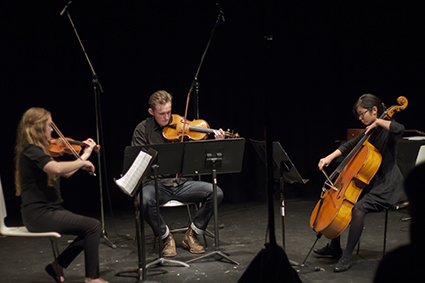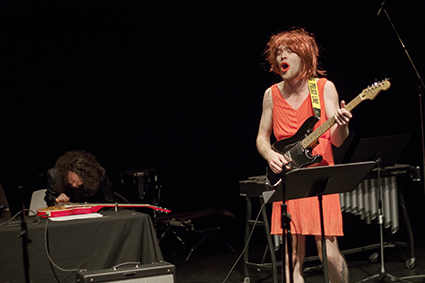 |
Breaking Out Young Composers’ Night photo Holly Jade |
The colours of the saxophone orchestra complemented Gillam’s text well and gave the work a sense of storytelling. Banyard demonstrated a fine feel for orchestrating the ensemble, blurring and swelling chords between different parts and letting melodies unfold naturally through the ensemble.
The saxophonists remained on stage for Sean Bernard’s catchy Octagonal Raven, a lively work with a very cinematic feel. Sections of fast paced compound rhythms and melodic interaction between parts were interspersed with rich and sonorous moments that beautifully captured the resonance of the ensemble, though perhaps the orchestration felt a little over-saturated given the brief duration of the work and could have benefited from being scaled back for some moments of respite.
One of the highlights of the concert was Josiah Padmanabham’s Simulacra, a string trio that captured extended techniques and implemented them gesturally to create a very visceral work. It had a perfect sense of pace, drawing the audience in closely for intimate moments and allowing the sound to organically unfold outward. What I especially loved about the composer’s writing was that the ensemble felt entirely cohesive, the music flowing between the three instruments interactively and combining to make a very clear and rounded rather than disjointed sound. Padmanabham’s use of extended techniques reminded me of the work of Finnish Composer Kaija Saariaho, who also works closely with extended string techniques and quite similar spectral sound worlds. One of the dangers of this kind of music is that it can become too driven by special effects and gimmicks, but this work steered clear of cliché to deliver a beautifully sinuous and satisfying sound.
John Pax’s peculiar solo for bass clarinet, Foreshortening, focused almost exclusively on exploring the possibilities of breathy, fluttering sounds, drawing its tension from silences. The work brought the listener in very closely to its narrow subject matter in a way that meant even very small changes in texture made for moments of impetus. Pax only allowed a few brief moments for the sonorous bass notes to emerge and in doing so rendered these moments, near the end of the piece, quite satisfying. One has to admire Pax’s compositional bravery and commitment to exploring this sound world.
Laura Halligan’s theatrical Desperada for violin and electronics immediately called to mind the ferocious string writing of Bernard Herrmann, blending a vicious violin sound with electronics and a relentlessly thumping bass. Perhaps the work could have benefited from more live input in place of predetermined sound, but nonetheless made for an immersively creepy piece.
James Bradbury’s Traced Over for guitar and electronics began with the haunting sound of bowed guitar strings, which was then spatialised and manipulated. Over the course of the work Bradbury developed a very immersive sound world by working with spectral data from the guitar. In his program note he describes how he aimed for a rising complexity in the guitar’s material to confuse the electronics and bring a disparity between the two areas of timbre. It was a little hard to actually hear this change as I thought most of the development was derived from harmonic and dynamic changes rather than timbral ones, but it was nonetheless an interesting concept to explore.
After a short intermission, two acoustic guitarists took the stage to perform Olivia Davies’ Derelict, which explored a very sparse, dry sound world. Davies utilized a combination of effects from foreign objects such as a pencil and a paperclip to interfere with the strings, as well as tapping the body of the guitar. Though the piece took a while to get going, once it did Davies used repeating motivic cells to build a very convincing ‘derelict’ atmosphere and demonstrated a fine feel for rhythmic impetus.
Josten Myburgh’s Doctor for soprano, two percussionists and electronics dealt with an unusual sense of temporality. The work began with an assault of unbroken, harsh noise followed by a snap to a period of silence that just nudged the boundary of awkwardness, and then introduced acoustic material. Myburgh blended the sound of two vibraphones beautifully with an electronic texture of soft crackles, high pitched frequencies and a gentle spectral glow, contrasting this quite pleasant texture with interruptions from a cardboard box full of metal objects. He also called for a piece of styrofoam to be bowed, an assault on the ears that I can probably never forgive. A combination of the slow pace and mostly high pitch of the soprano line made Josh Wells’ text a little hard to discern, making it feel a little superfluous—perhaps a missed opportunity. Nevertheless, Myburgh commanded the audience’s interest through his use of blunt jumps and quick juxtapositions, and there was a certain feel of timelessness to long periods of unchanging texture. It became the sort of piece that you could get lost in and not be sure whether you had been there for five or 20 minutes.
Tom Bomb by Elise Reitze was a short and funky piece for three percussionists. It seemed quite presentational, almost ritualistic, asking for the three drummers to huddle around a bass drum and calling for visual effects such as a Mexican wave of the six hands on the drum. It focused on continually introducing small rhythmic elements to a continually expanding texture, Reitze using the rhythmic momentum generated to build to some very satisfying climaxes.
Ben Christiansen’s quirky and disjointed Carousel drew us in to quite a sparse sound world. The ensemble of two saxophones, vibraphone, marimba and piano seem to blurt out different gestures interspersed with periods of silence. It felt like it had the potential to go somewhere but instead just sat on its material, and perhaps that’s all it really needed to do.
 |
Breaking Out Young Composers’ Night photo Holly Jade |
Breaking Out Young Composers’ Night, Totally Huge New Music Festival, PICA, Perth, 20 May
© Alex Turley; for permission to reproduce apply to [email protected]








 back
back